At the border
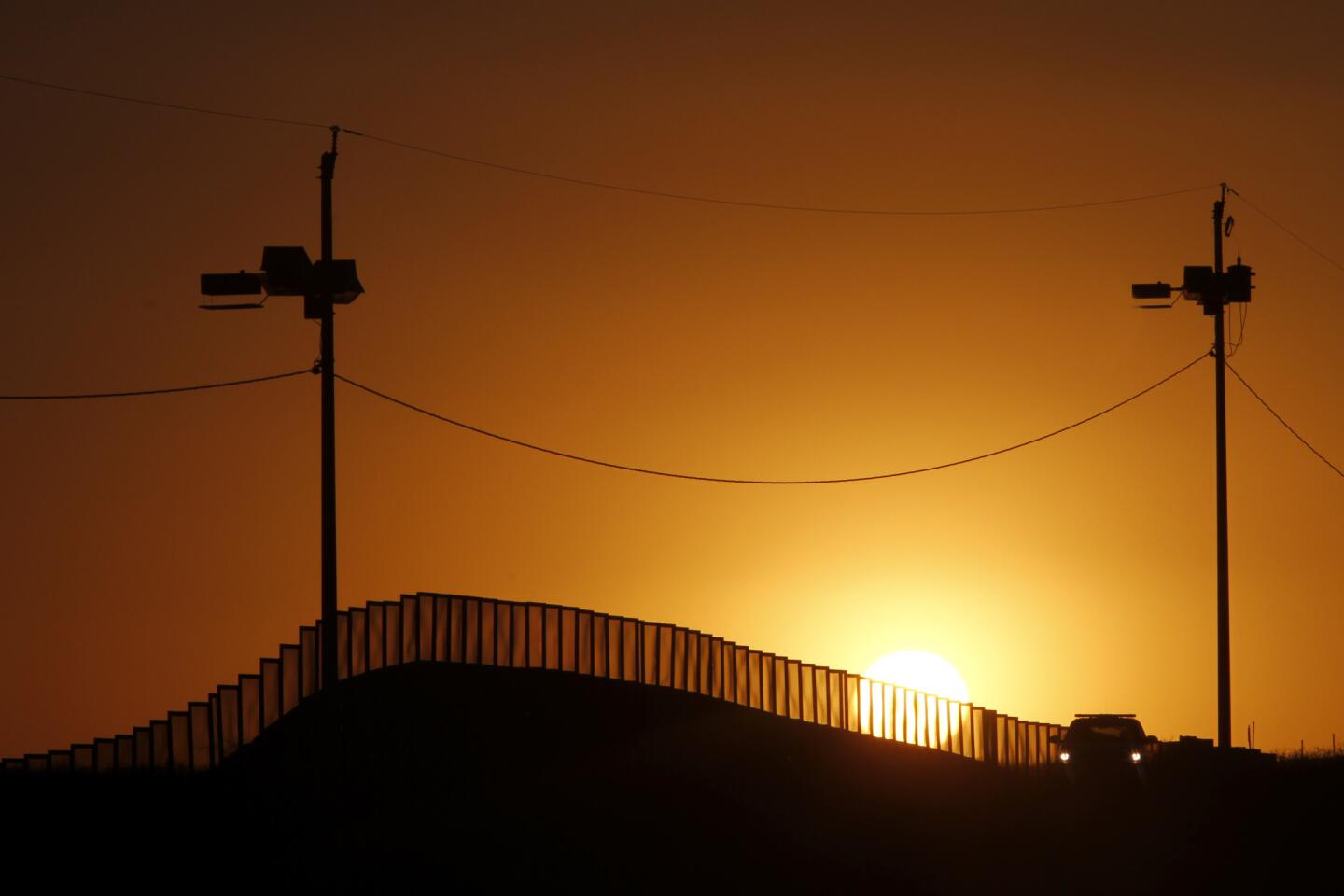
Sunset at the U.S./Mexico border fence a couple blocks west of the Naco, Arizona, Port of Entry. (Don Bartletti / Los Angeles Times)
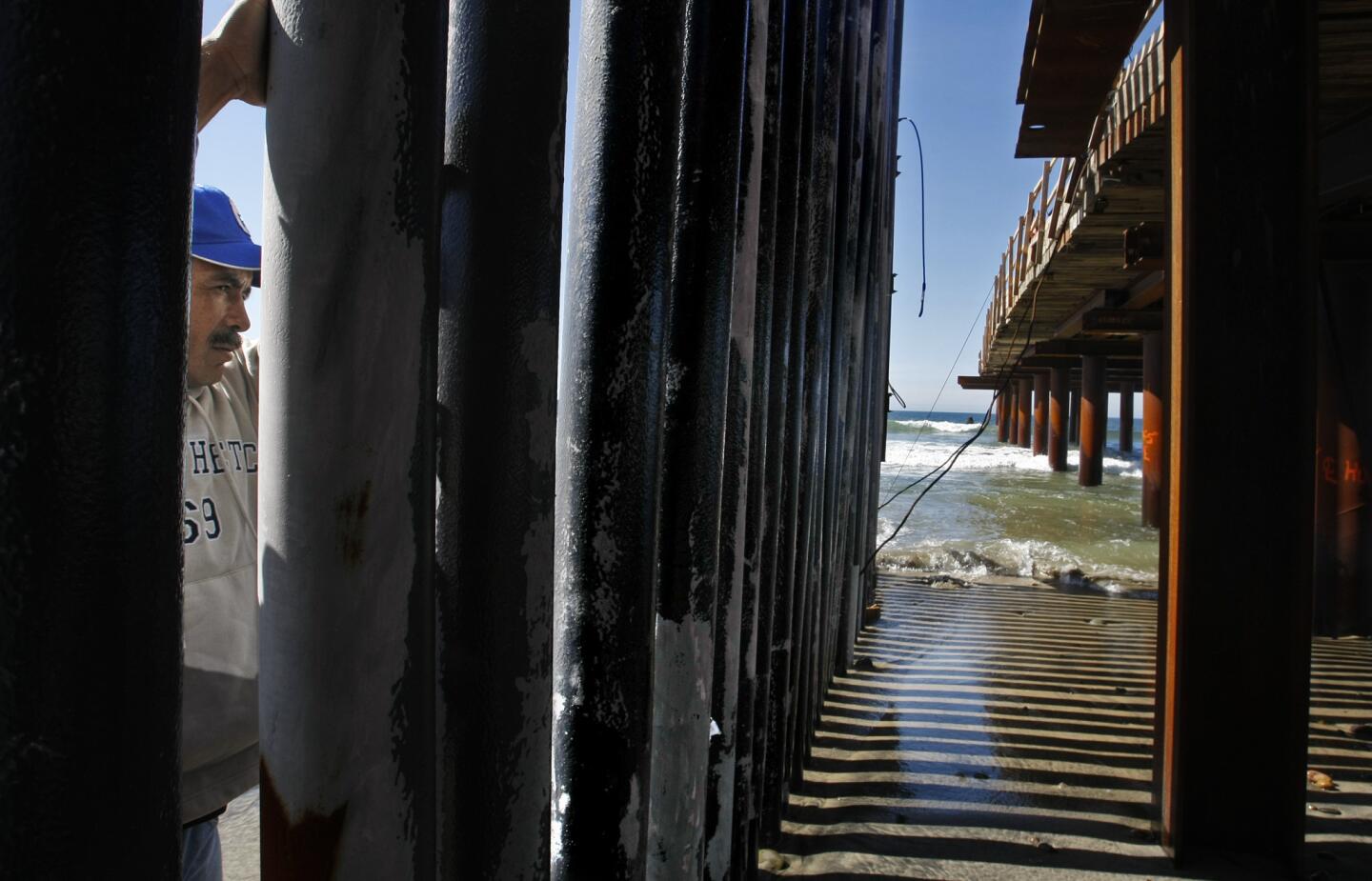
JANUARY 30, 2012. PLAYAS TIJUANA, MEXICO. Luis Rodriguez looks northward, through the 18-foot-high steel posts of the border fence where it ends on the beach in Tijuana, Mexico. Of his 2 daughters in Los Angeles he said, “ I just want to go over there and be with my girls. It’s important that they know that I’m fighting, doing everything possible to see them again, to hug them again.” (Don Bartletti / Los Angeles Times)
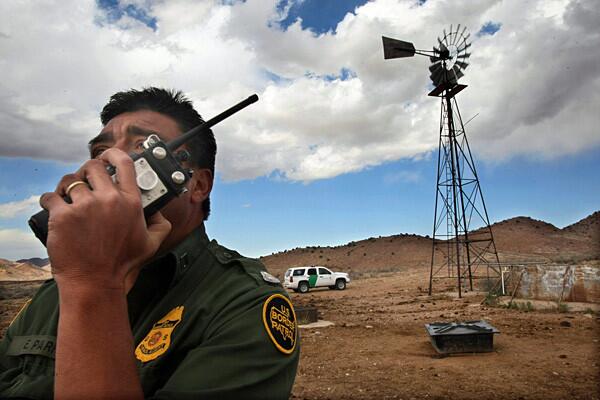
Supervisory Border Patrol Agent Eddie Parra at a windmill at the base of the Peloncillo Mountains near Rodeo, New Mexico. (Don Bartletti / Los Angeles Times)
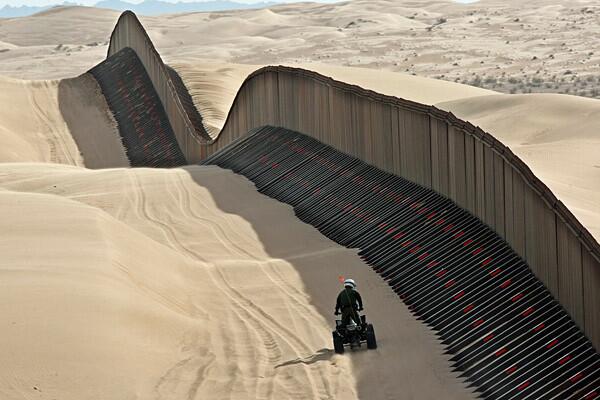
A U.S. Border Patrol agent inspects the “floating fence” that sits atop the powdery Imperial San Dunes. Angled buttresses on either side give the fence stability atop the wind-blown sand. (Don Bartletti / Los Angeles Times)
Advertisement
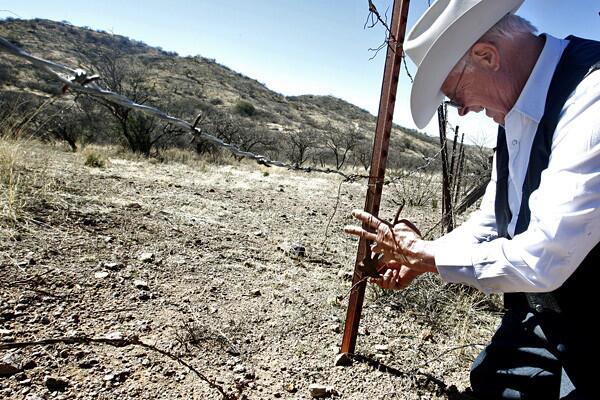
Cattle rancher Jim Chilton repairs the barbed wire fence where his ranch shares the border with Mexico about 19 miles south of Arivaca, Arizona. Cartel drug runners and illegal migrants cut the wire almost every day. (Don Bartletti / Los Angeles Times)
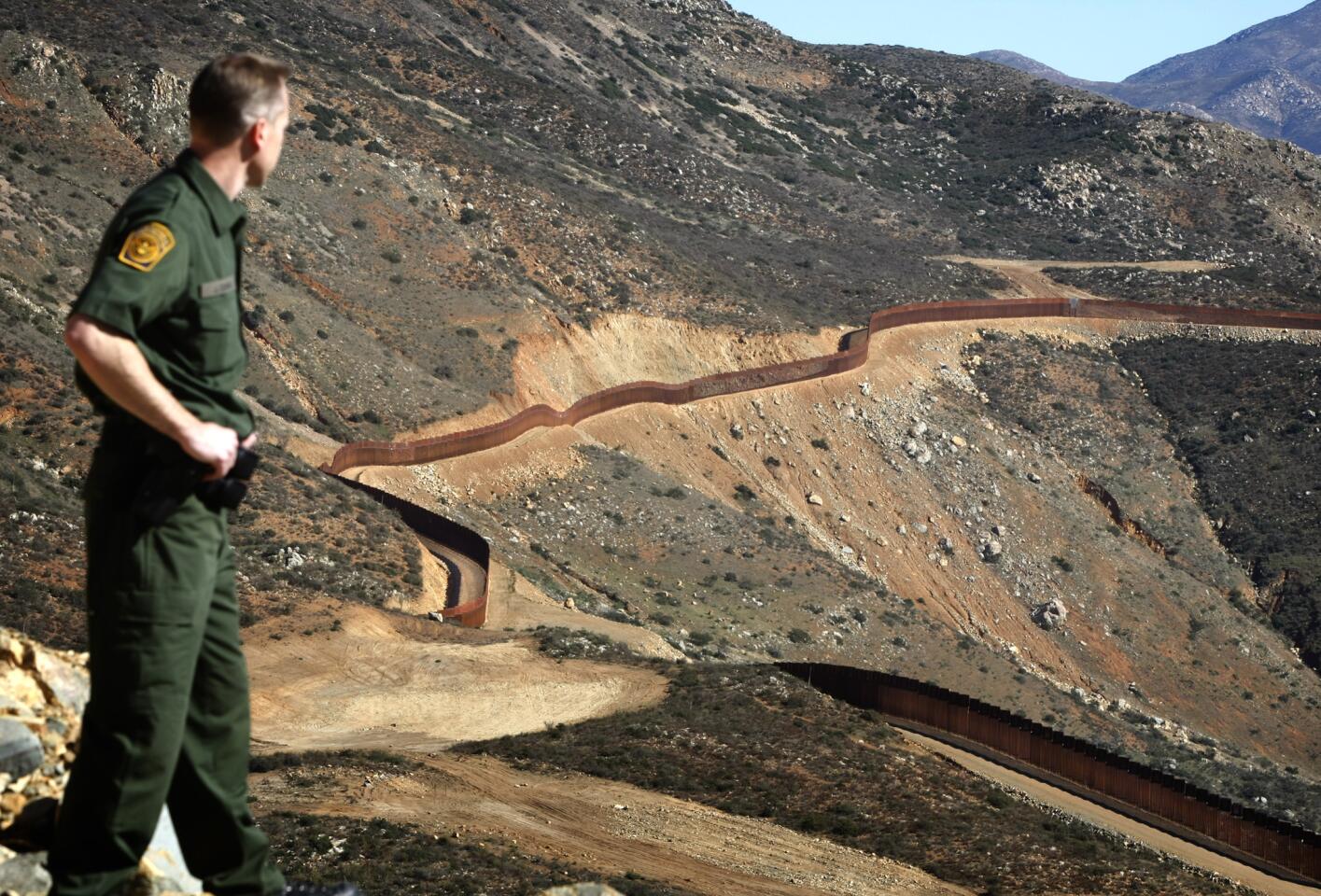
U.S. Border Patrol agent Jerome Conlin gazes across the base of Otay Mountain at a recently completed stretch of the U.S.-Mexico border fence. The 3.6 mile long, 18-ft-high barrier through rugged terrain east of San Ysidro cost $57.7 million to construct. (Don Bartletti / Los Angeles Times)
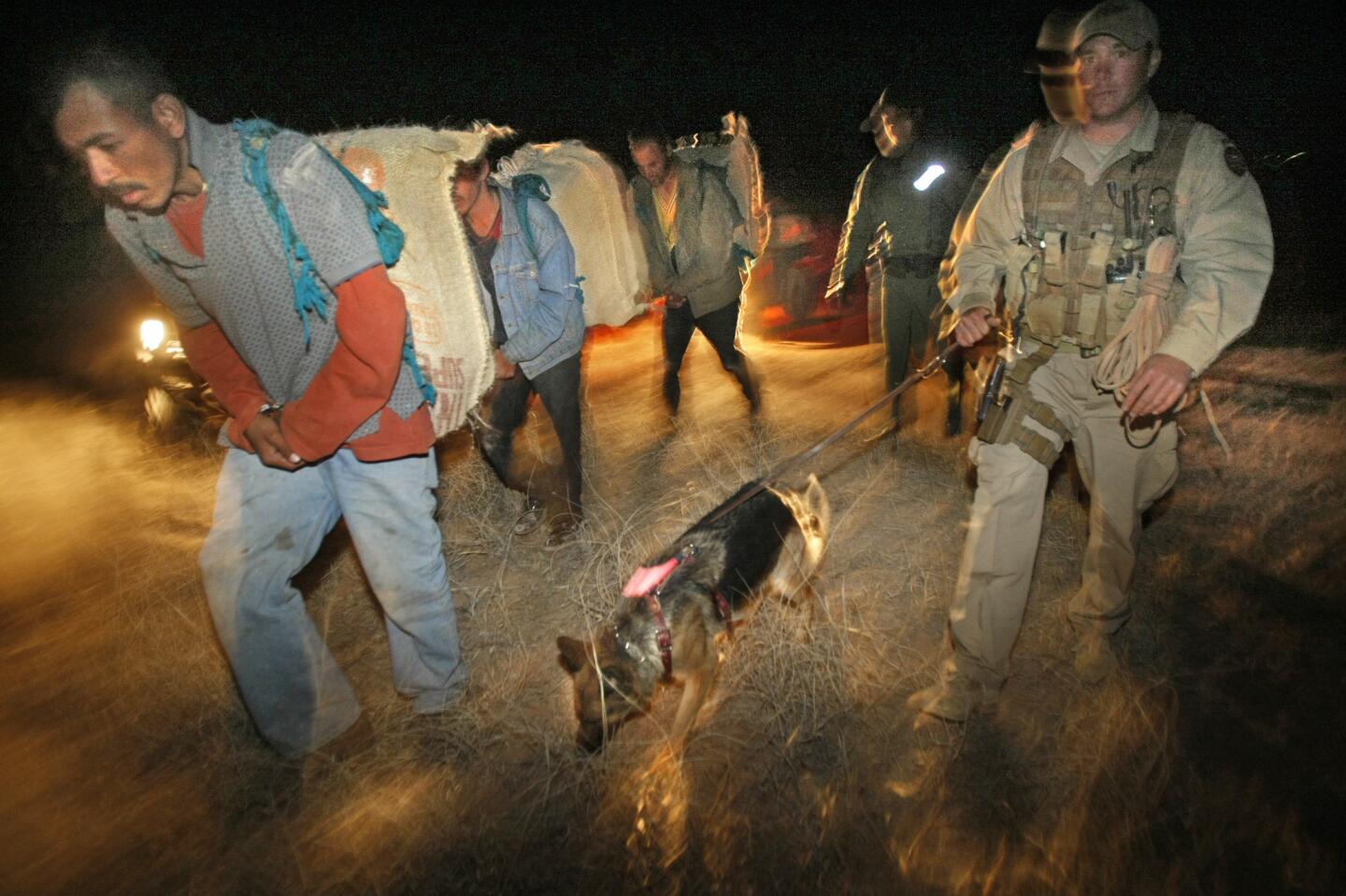
Patrick Limbaugh with the U.S. Border Patrol escorts apprehended smugglers carrying backpacks of marijuana through the desert near Rodeo, New Mexico. 4 Mexican men and 275 pounds of marijuana were seized. (Don Bartletti / Los Angeles Times)
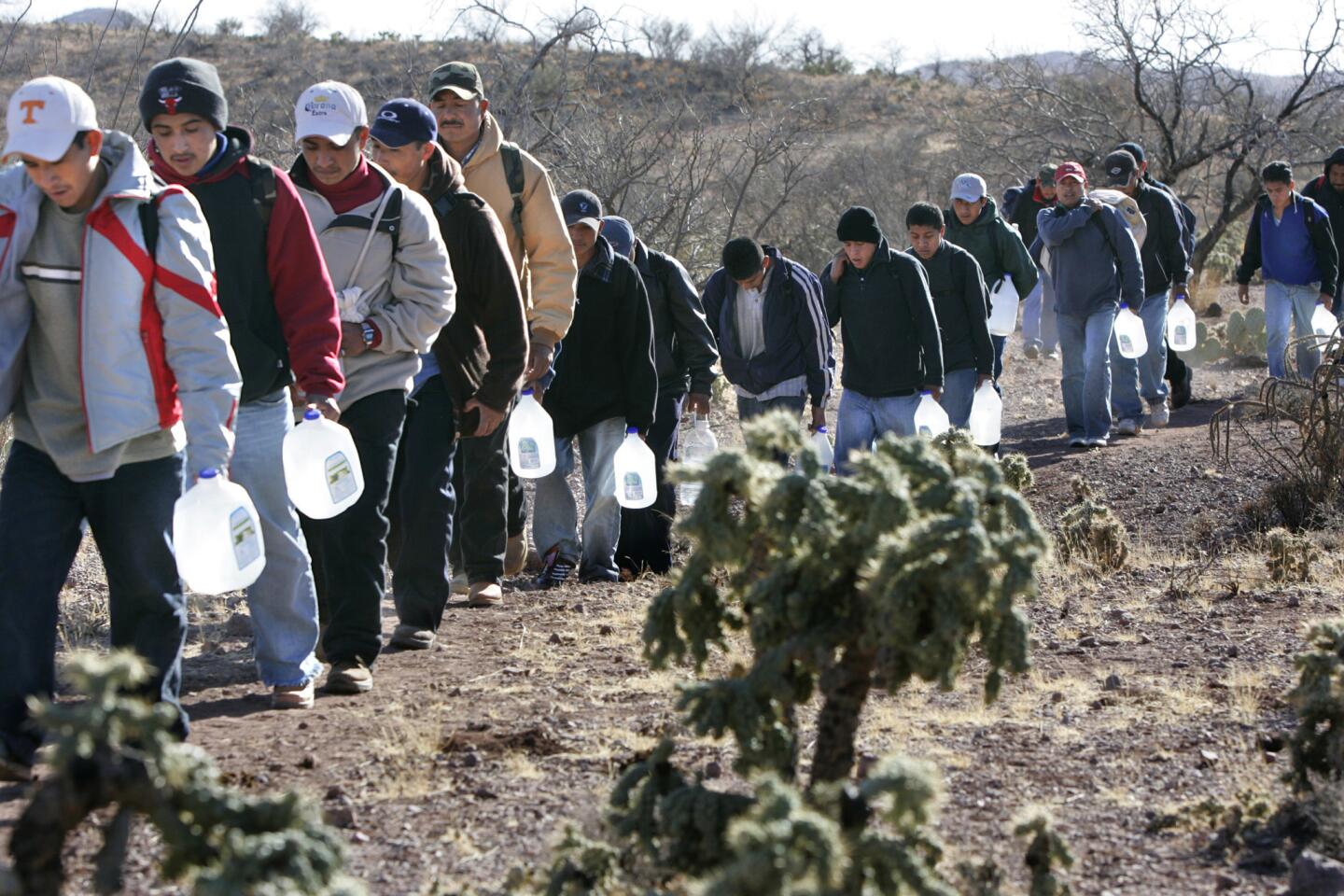
Mexican migrants with jugs of drinking water follow a smuggler across the Chilton Cattle Ranch in southern Arizona. Backpacks hold food for a 3-4 day ordeal. In this part of the Altar Valley east of Sasabe, Arizona a 4-wire cattle fence is all that marks the US/Mexico borderline. The Border Patrol uses their enforcement resources about 15-20 miles north of the line. (Don Bartletti / Los Angeles Times)
Advertisement
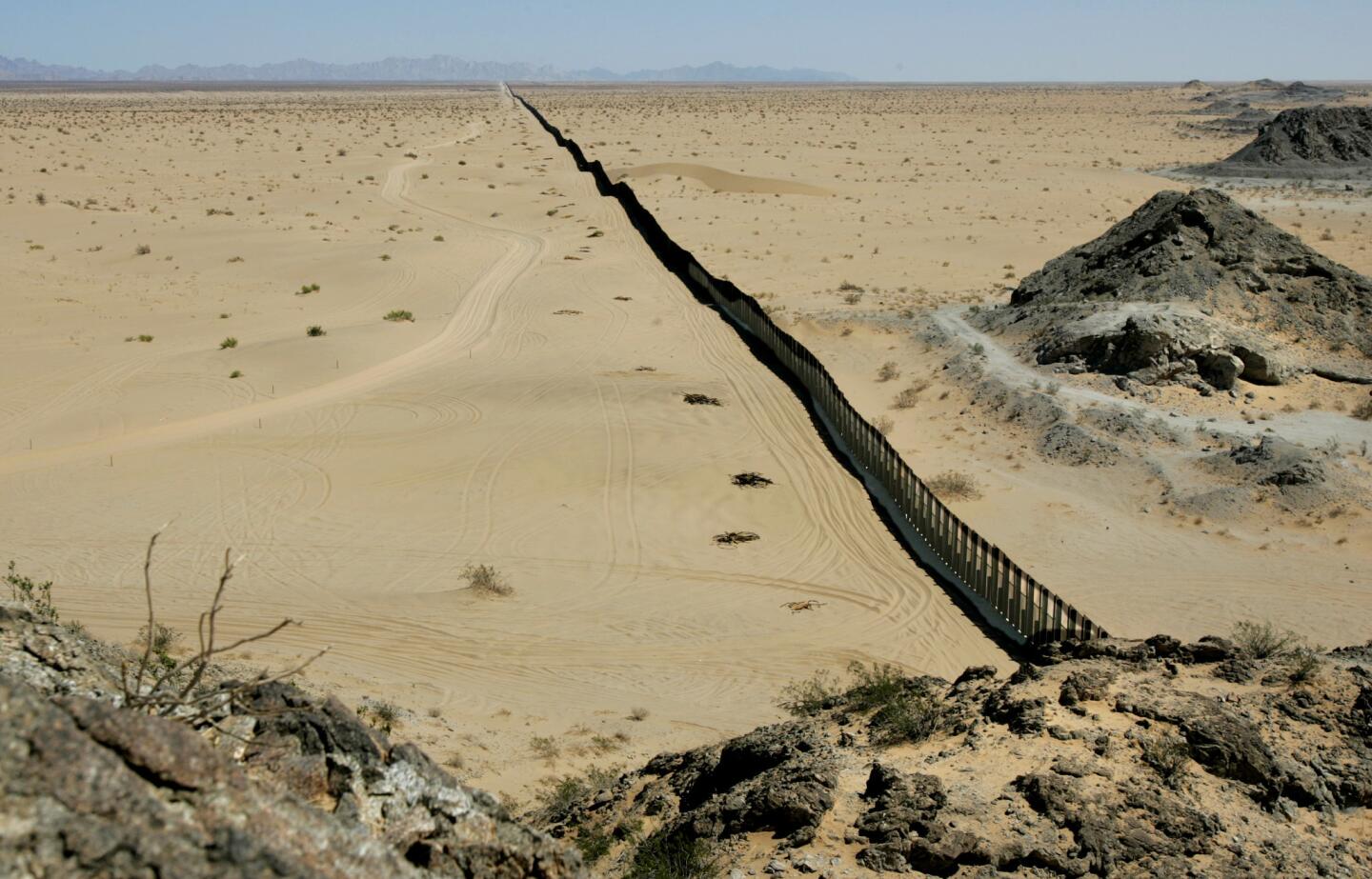
Dubbed “the longest fence”, it stretches about 40 miles along the desert borderline east of San Luis, Arizona. The Mexican state of Sonora is on the right. (Don Bartletti / Los Angeles Times)
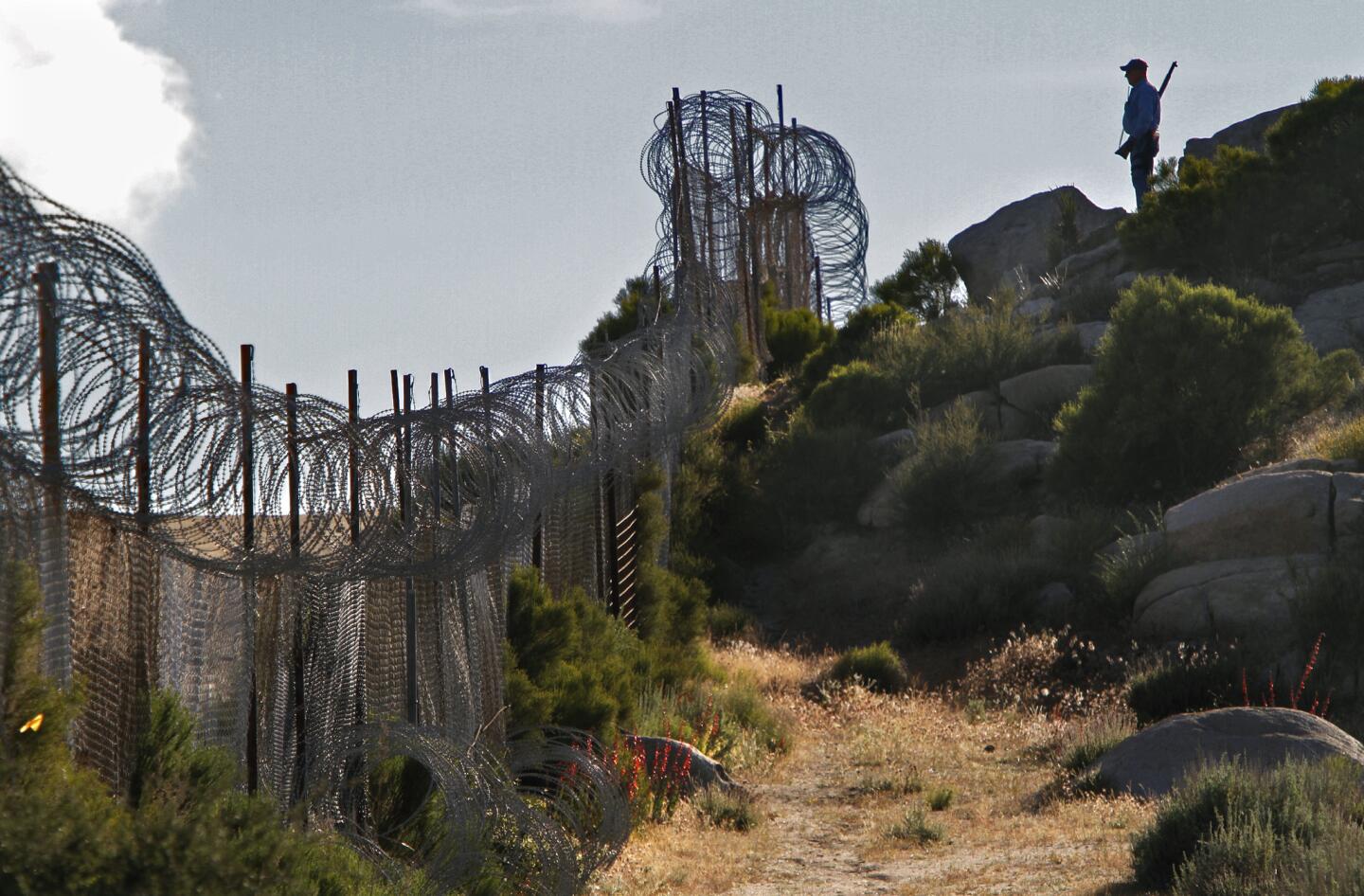
With a rifle slung over his shoulder, Bob Maupin gazes towards Mexico over a fortified fence he built along the border to discourage illegal immigrants from trampling over his property. His 250-acre ranch is about 65 miles east of San Diego. Since the U.S. Government erected an even higher steel fence parallel to his he says he hasn’t been bothered as much by northbound Mexican migrants or drug smugglers. (Don Bartletti / Los Angeles Times)
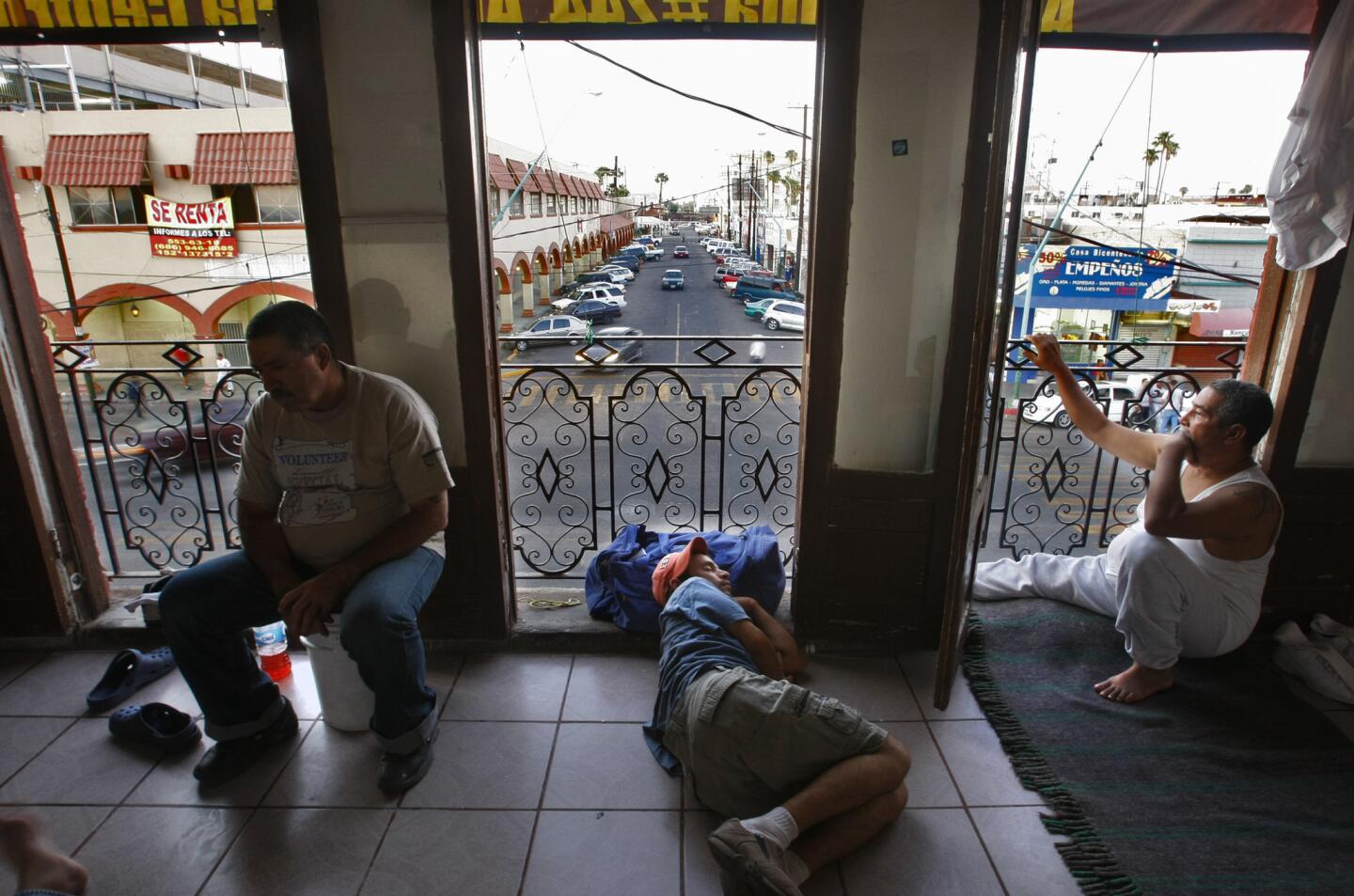
Mexican citizens recently deported from the U.S. rest in the Hotel of the Deported Migrant in downtown Mexicali, Mexico. The border with Calexico, California is 3 blocks out the window. (Don Bartletti / Los Angeles Times)
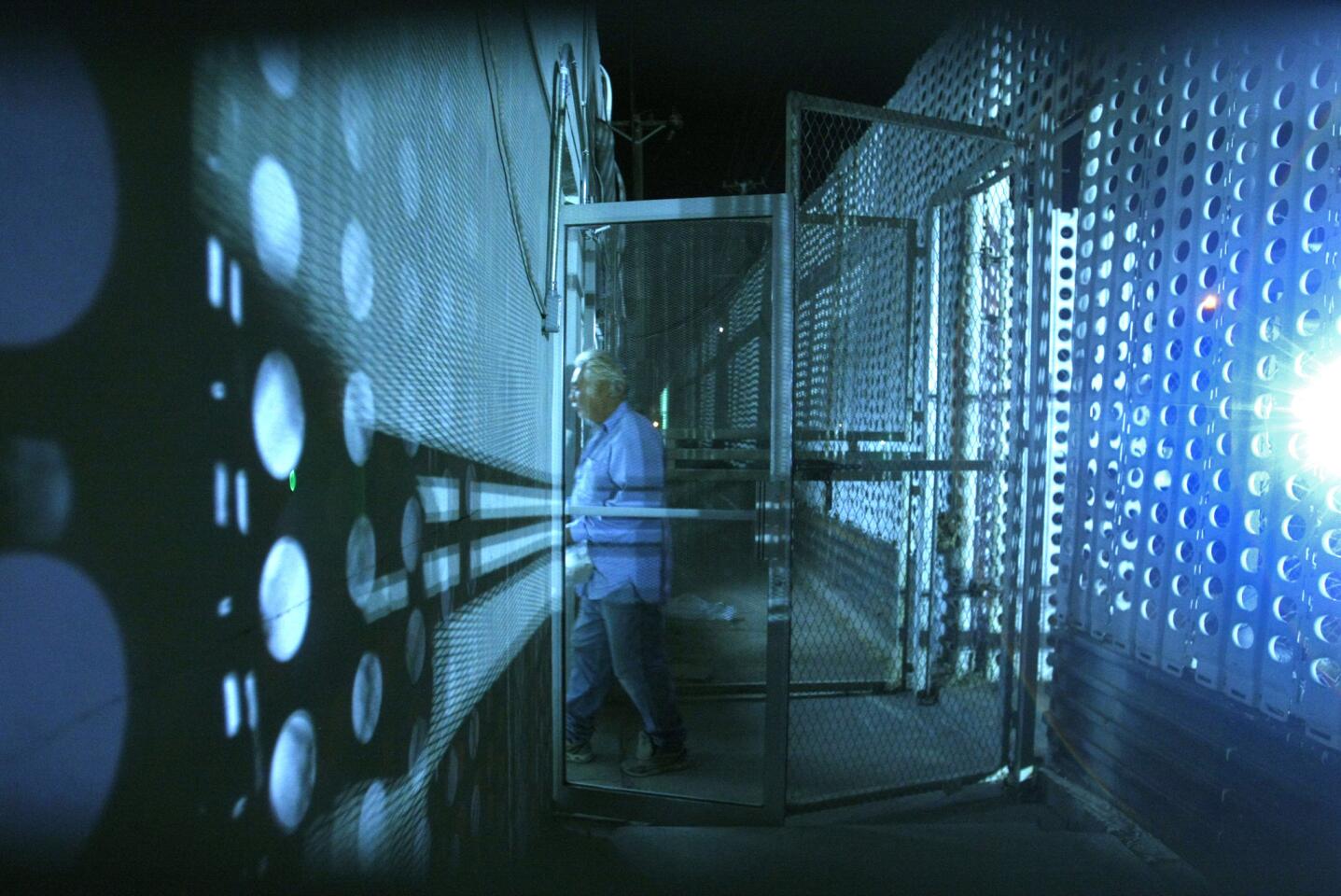
A Mexican citizen being deported from the United States walks through a fenced gateway from Calexico, California on the right and into Mexicali, Mexico. (Don Bartletti / Los Angeles Times)
Advertisement
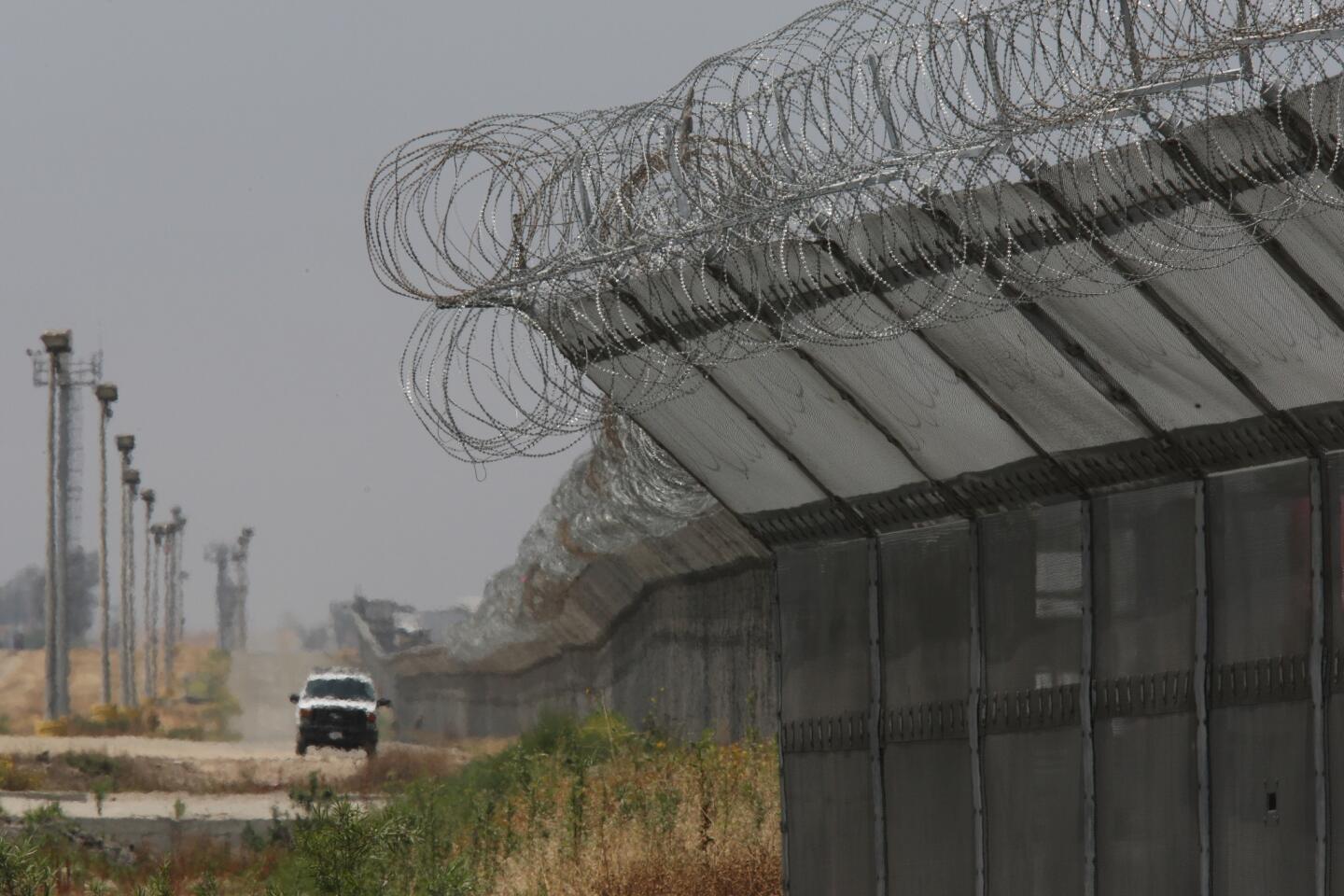
A U.S. Border Patrol vehicle drives along the cantilevered border fence that’s fortified with coils of razor-wire. The recently added wire is expected to stop smugglers who scale the 15-ft-high fence using improvised ladders. (Don Bartletti / Los Angeles Times)
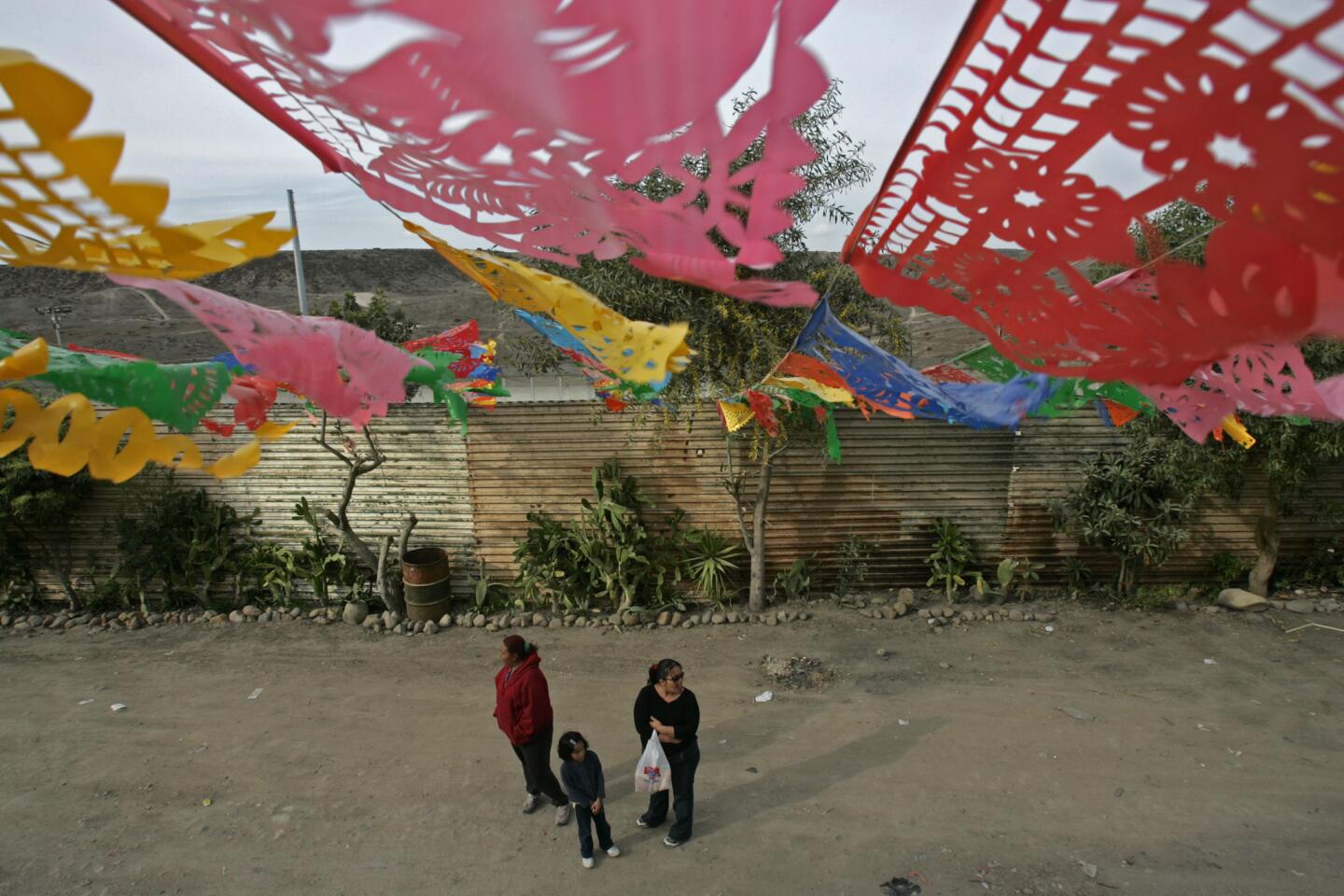
Locals congregate in Colonia Libertad where the rusty 1980’s-era 10-ft-high steel fence marks the border with the United States. Beyond it is a 15-ft-high secondary fence. Colorful plastic bunting stretches from Angelina Torrez’ front porch to the top of the fence. (Don Bartletti / Los Angeles Times)
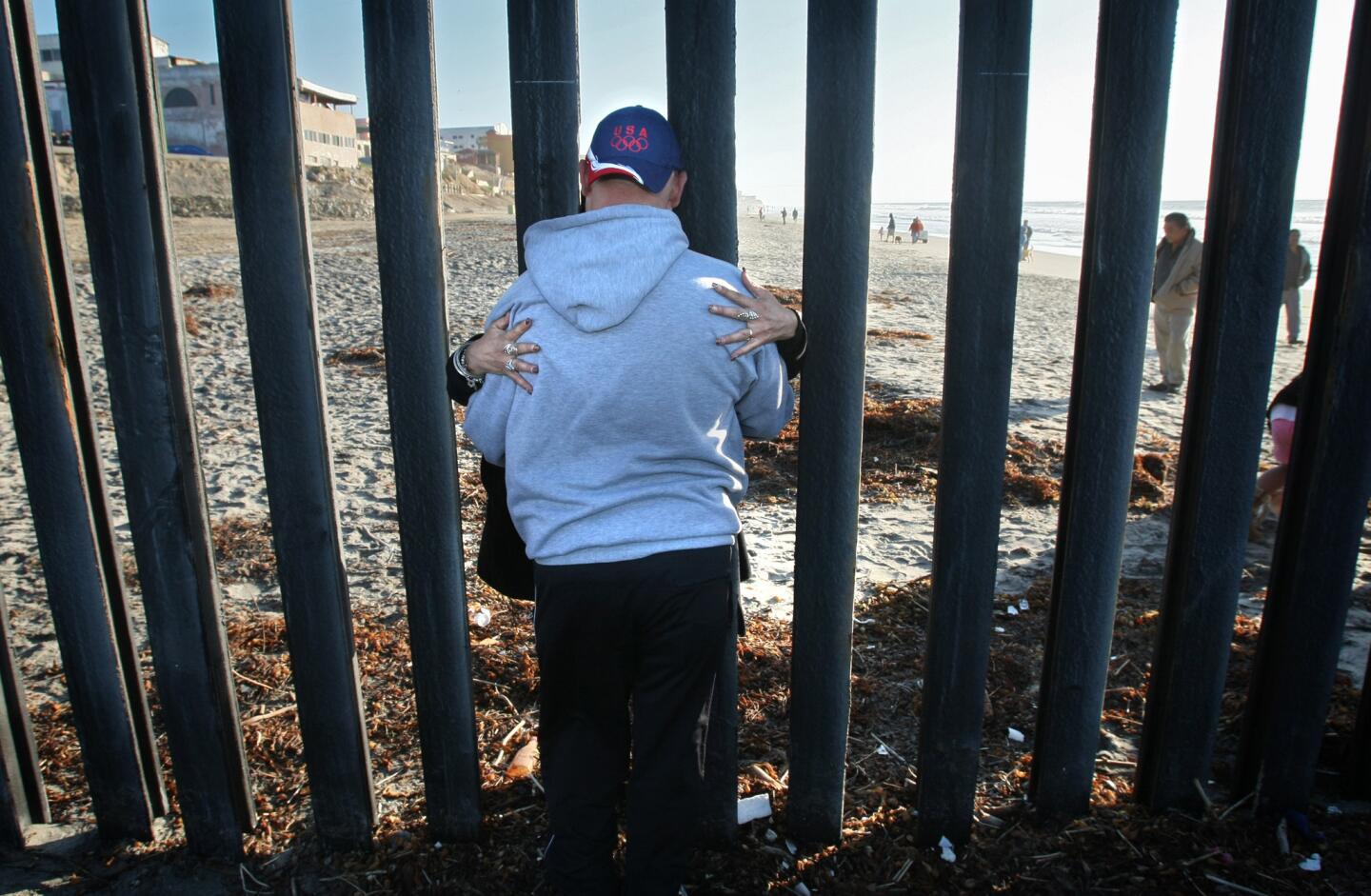
Fernando Orozco and his wife Marta Ramos embrace through the steel pickets of the U.S-Mexico border fence. Orozco is a legal U.S. resident who works in Santa Monica; his wife is a Mexican citizen. (Don Bartletti / Los Angeles Times)
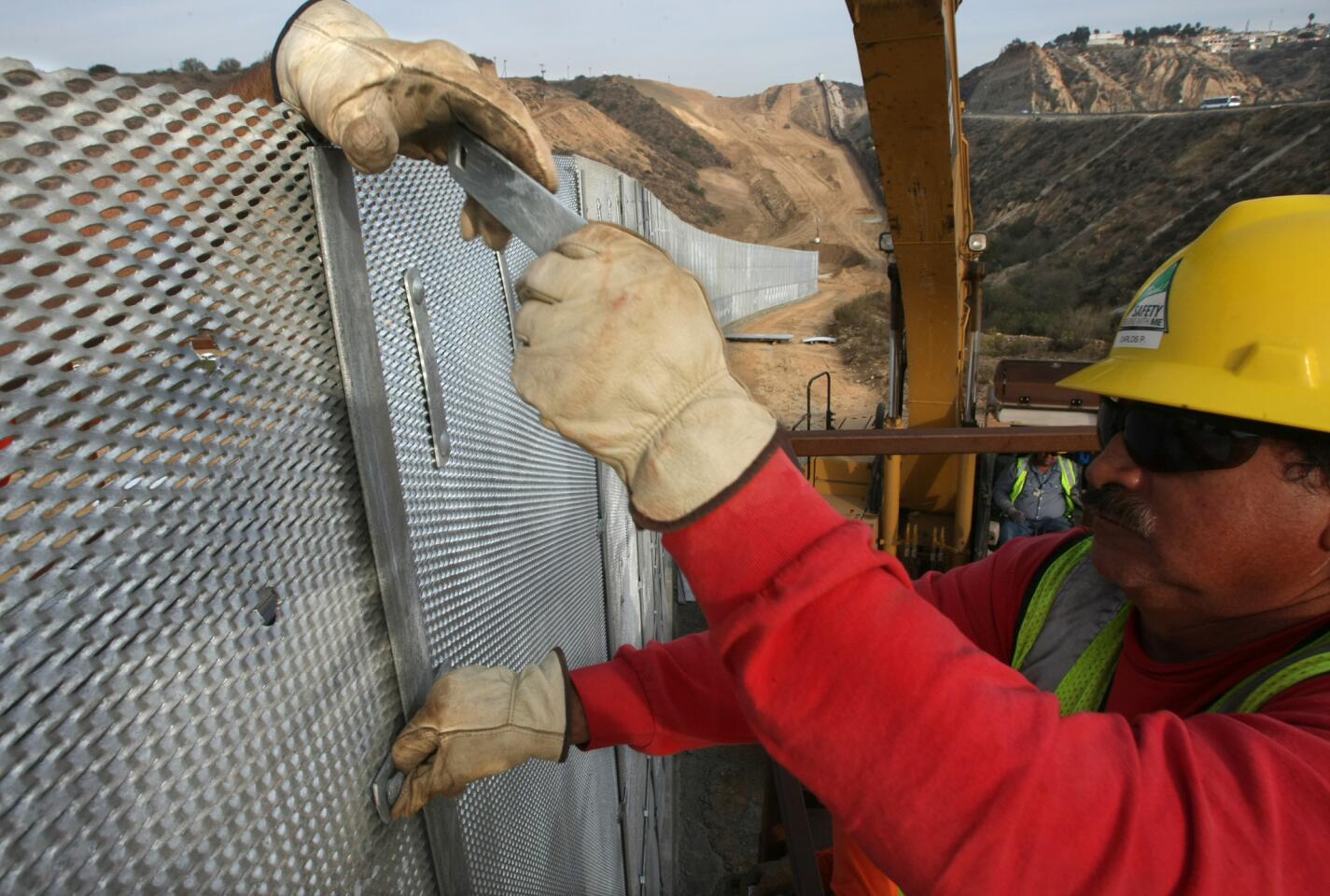
Construction workers connect steel panels on the new border fence that’s going up about 50 yards north of the borderline. Tijuana is to the right in the scene. The barrier will eventually extend up the hill. (Don Bartletti / Los Angeles Times)
Advertisement
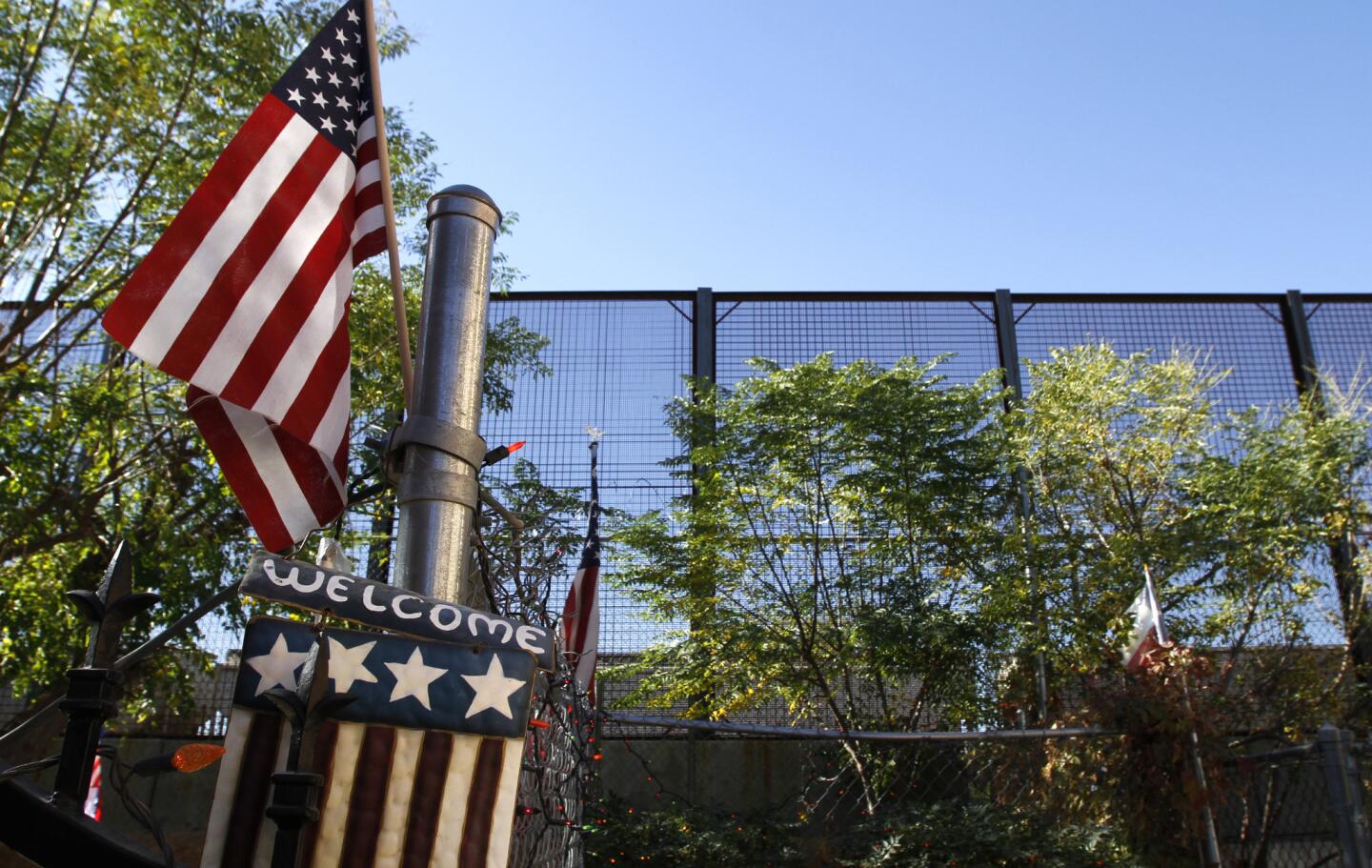
The towering steel border fence defines the southern boundary of the little neighborhood of Chihuahuita in El Paso, Texas. The peaceful, well-kept enclave is in stark contrast to the violence-plagued city of Ciudad Juarez, that’s out of sight on the other side of the barrier. (Don Bartletti / Los Angeles Times)
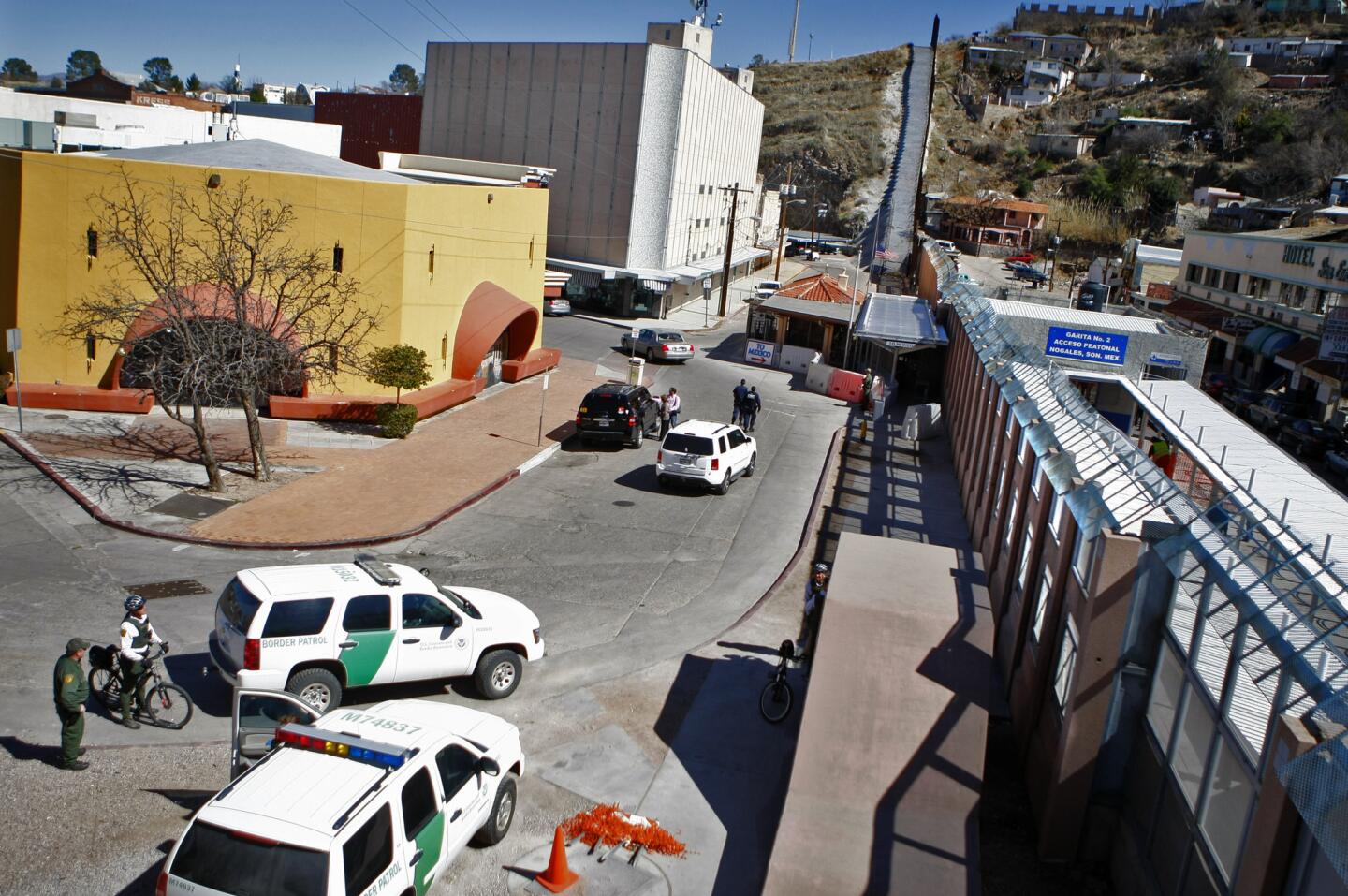
U.S. Border Patrol agents gather near the pedestrian crossing at the Nogales, Arizona, Port of Entry on Feb 26, 2013. Nogales, Sonora, Mexico is on the right. (Don Bartletti / Los Angeles Times)
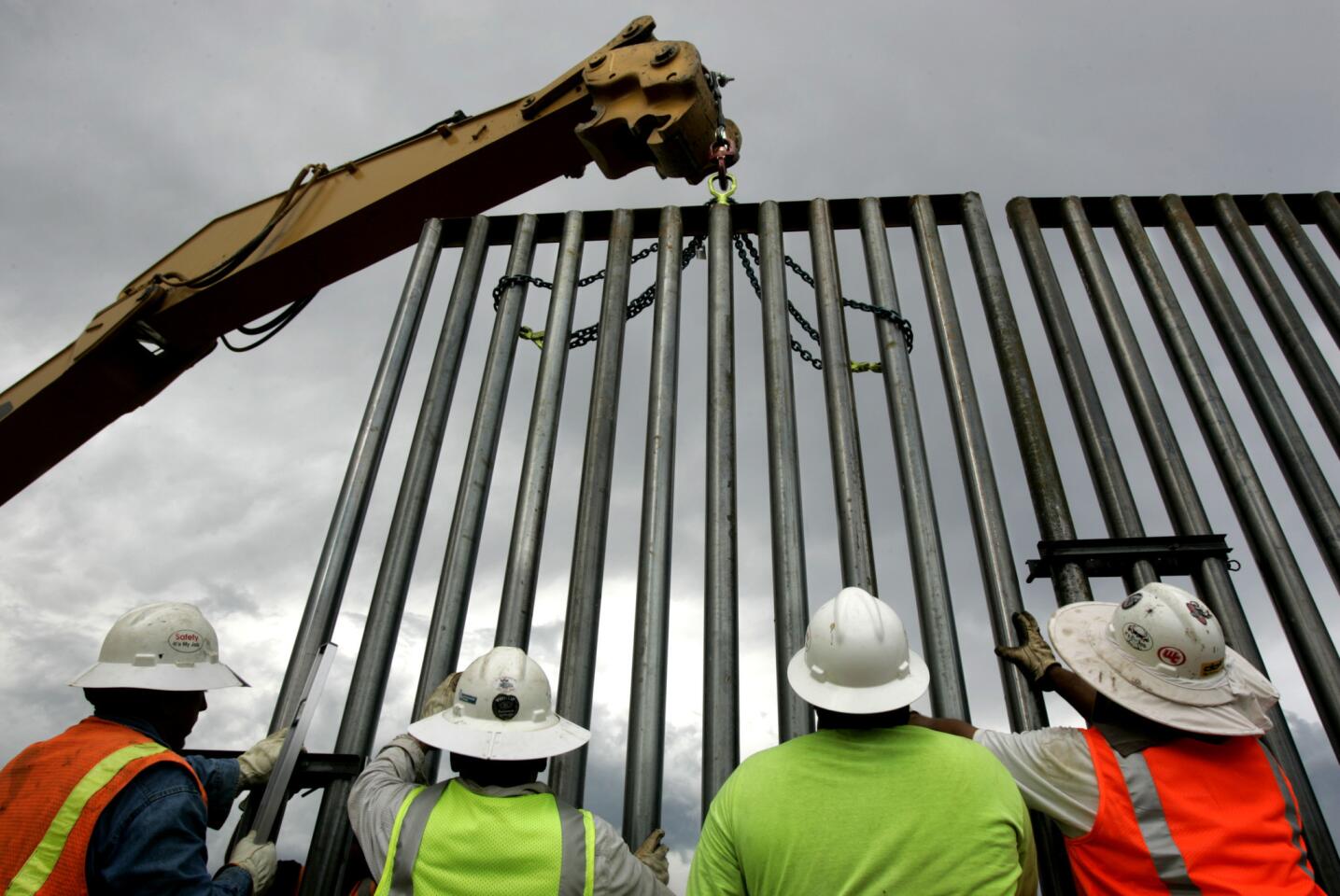
Workers guide a 15-ft-high section fencing into place just west of the Sasabe Port of Entry. (Don Bartletti / Los Angeles Times)
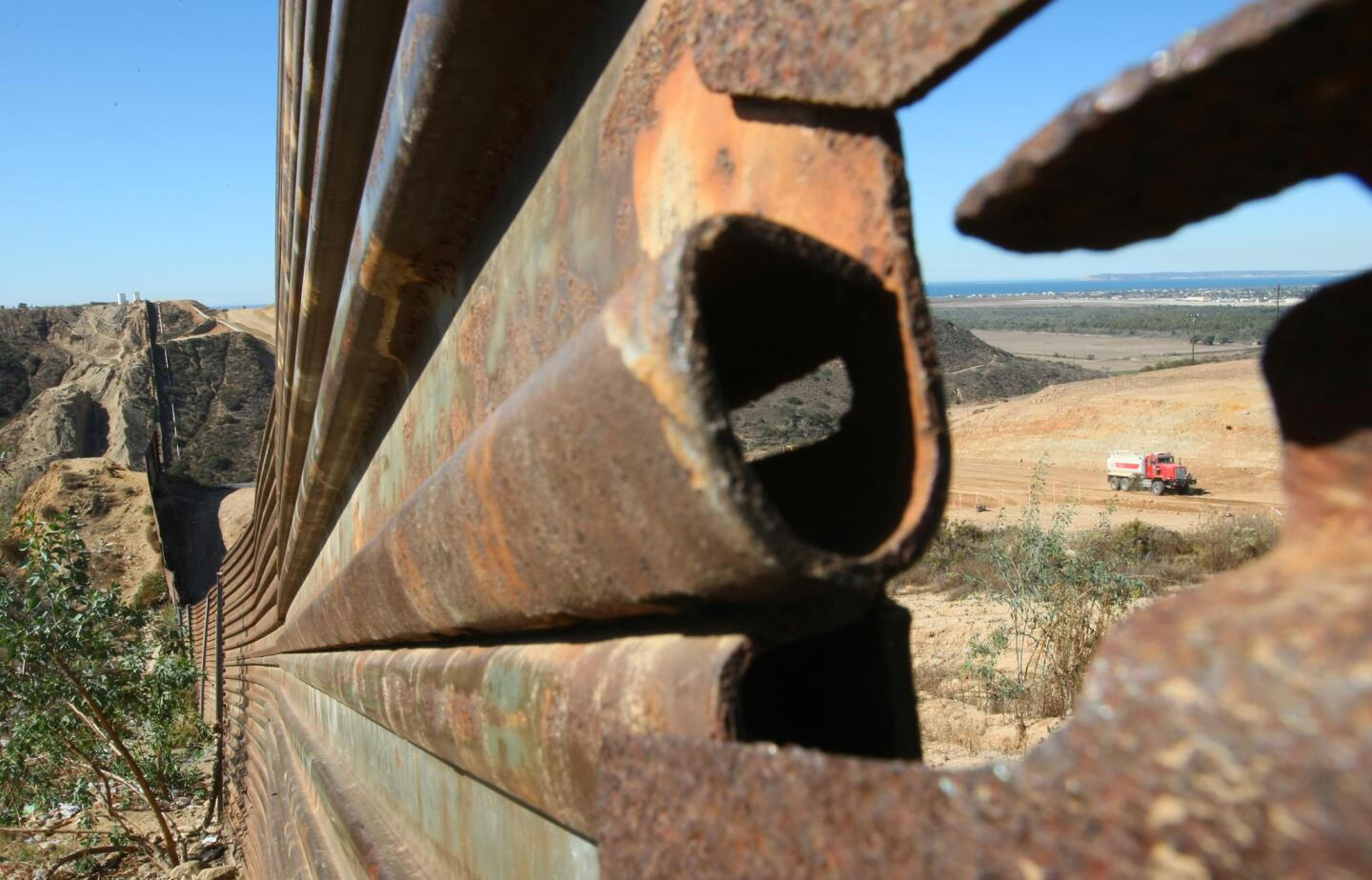
Looking from the Tijuana side through a small gap in the old rusty border fence, the new all¿weather road can be seen under construction a short distance to the north. (Don Bartletti / Los Angeles Times)
Advertisement
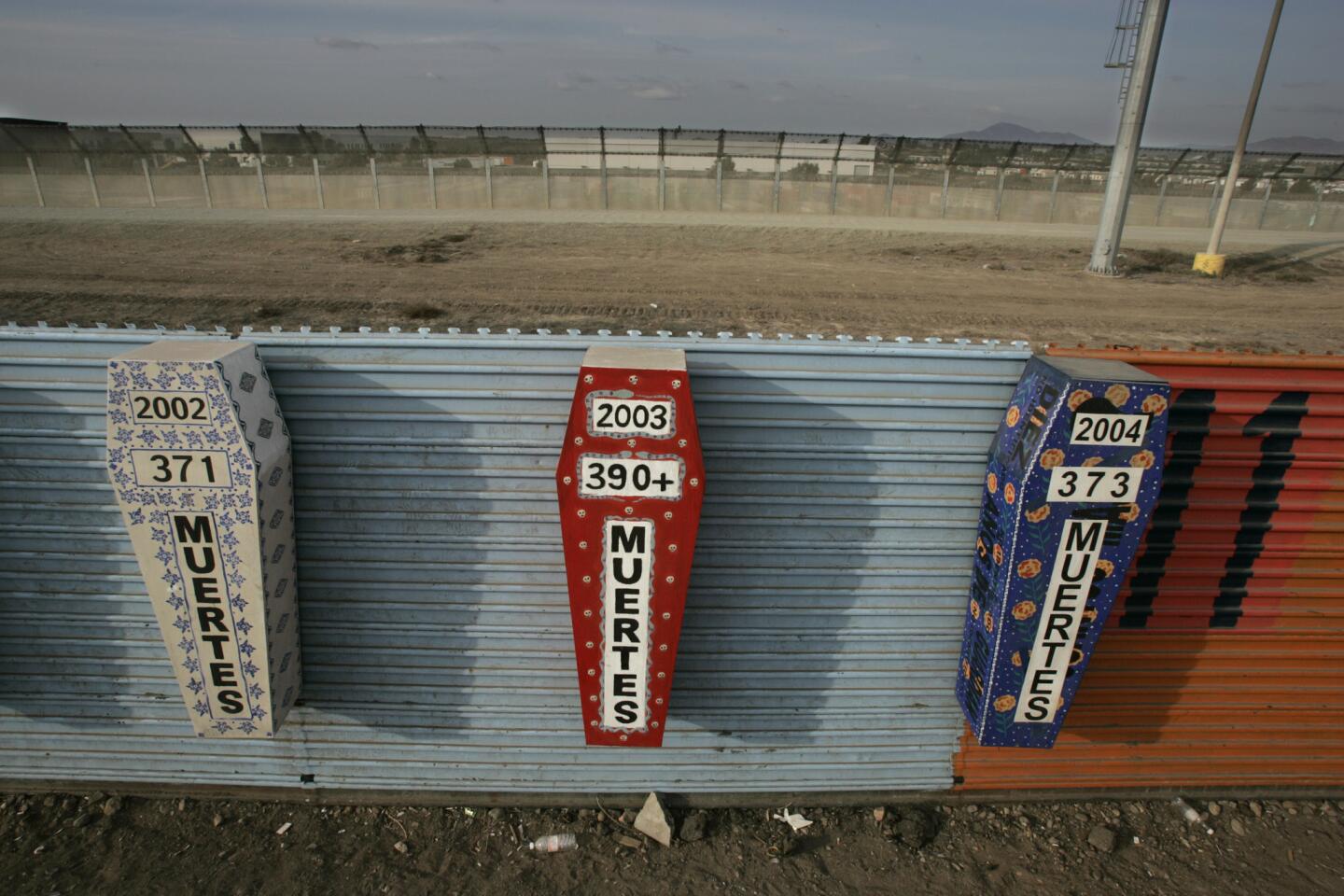
Lavishly decorated fake wooden coffins symbolizing the thousands of Mexicans and Central Americans who’ve lost their lives trying to cross into the U.S. are hung on the 10-ft-high rusty steel fence marks that the border with the United States. (Don Bartletti / Los Angeles Times)
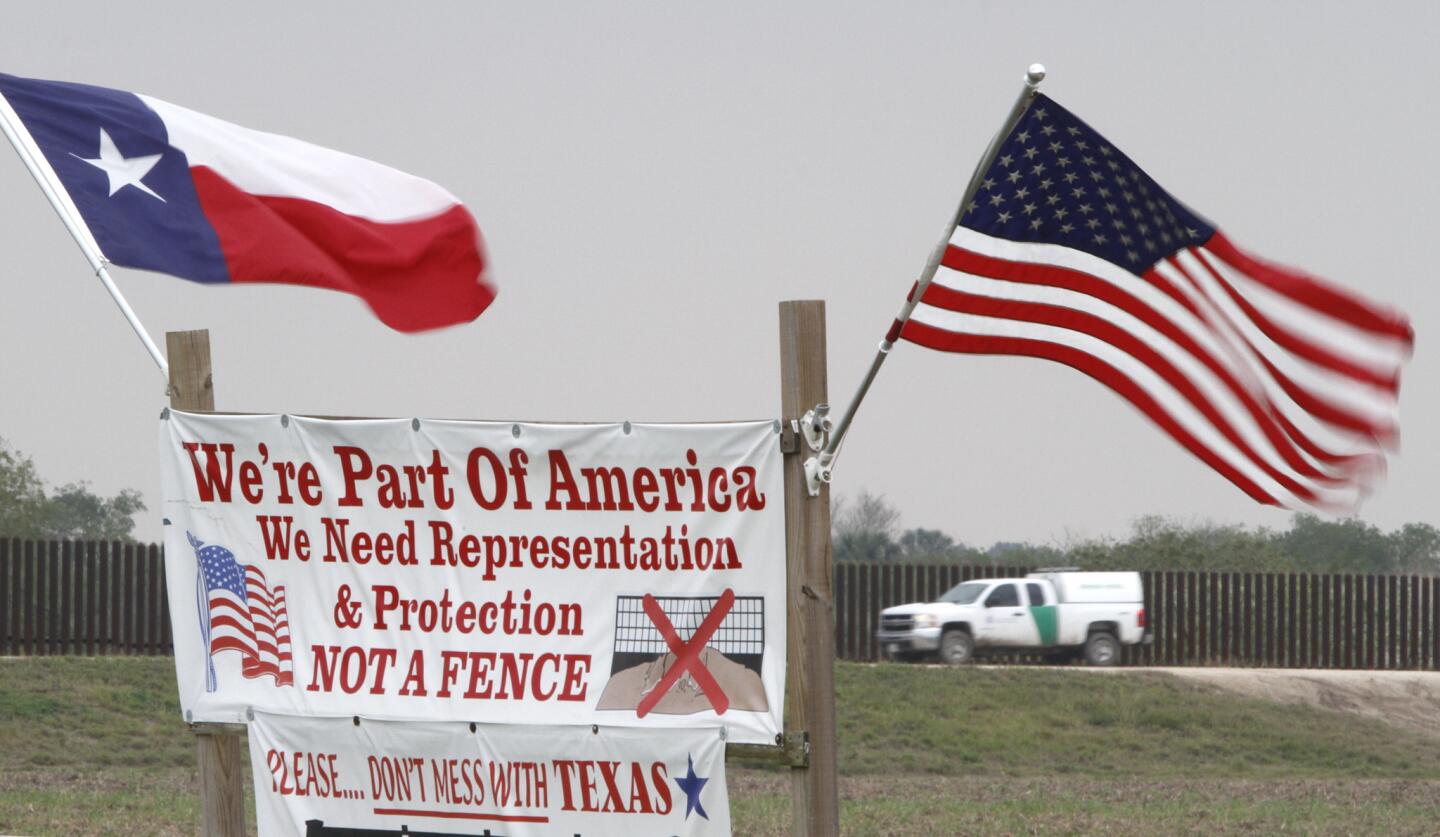
Pamela Taylor’s protest sign exclaims frustration with the U.S. Government’s construction of new border fencing that put her home and property on the south side of the barrier. She says it feels like her home of more than 40 years isn’t in America anymore. (Don Bartletti / Los Angeles Times)
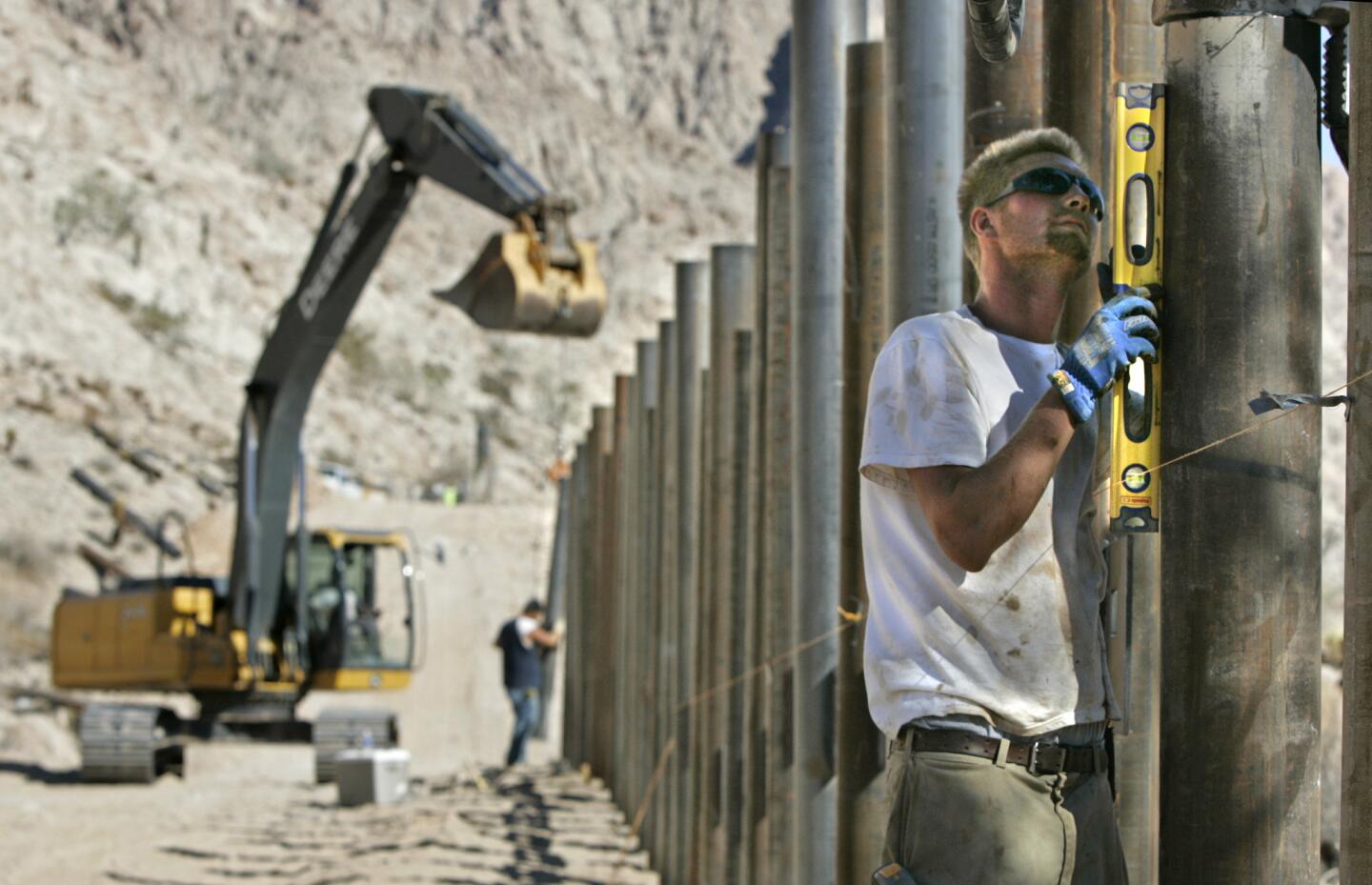
40 miles into the desert east of San Luis, Arizona, Dan Anskate checks the level of a 12” diameter steel fence post. All new fences along the border must be able to sustain a 40 m.p.h. impact from a vehicle. (Don Bartletti / Los Angeles Times)
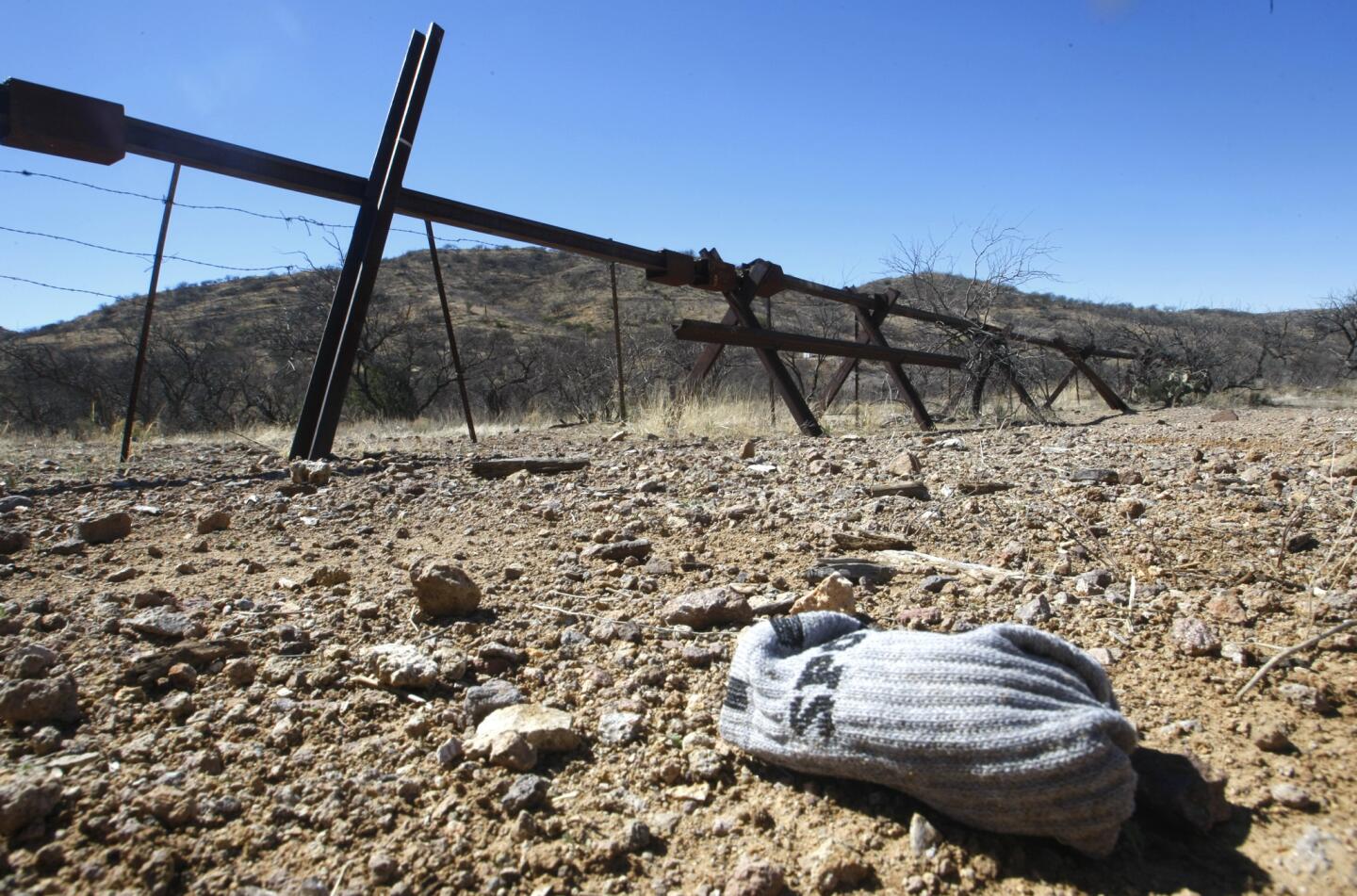
A Normandy-style barrier marks the boundry of Sonora, Mexico and the Chilton cattle ranch in Arivaca, Arizona, on Feb 23, 2013. Made of steel railroad rails, it serves to stop smuggler’s from illegally driving north into Arizona. A bundled pair of clean socks was probably dropped by one of many illegal immigrants who regularly walk north into the U.S. through the ranch. (Don Bartletti / Los Angeles Times)
Advertisement
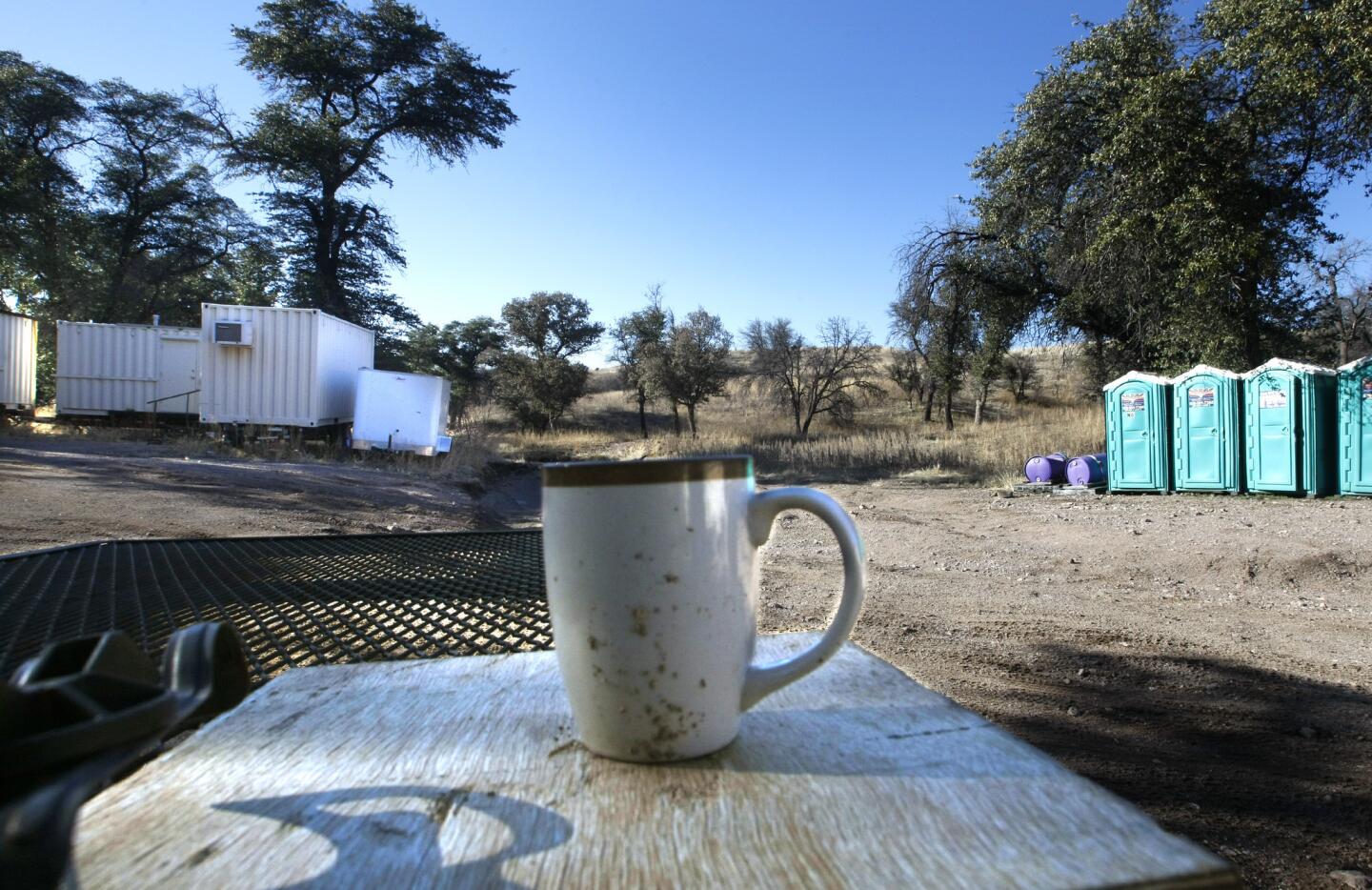
A coffee cup sits on a table at an abandoned U.S. Border Patrol forward operating base near Arivaca, Arizona. Before it was shuttered due to budget shortages related to overtime costs, agents were based here 24-hours per day, putting them much closer to the border. (Don Bartletti / Los Angeles Times)







